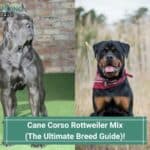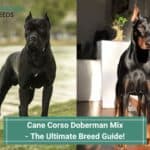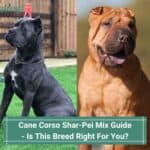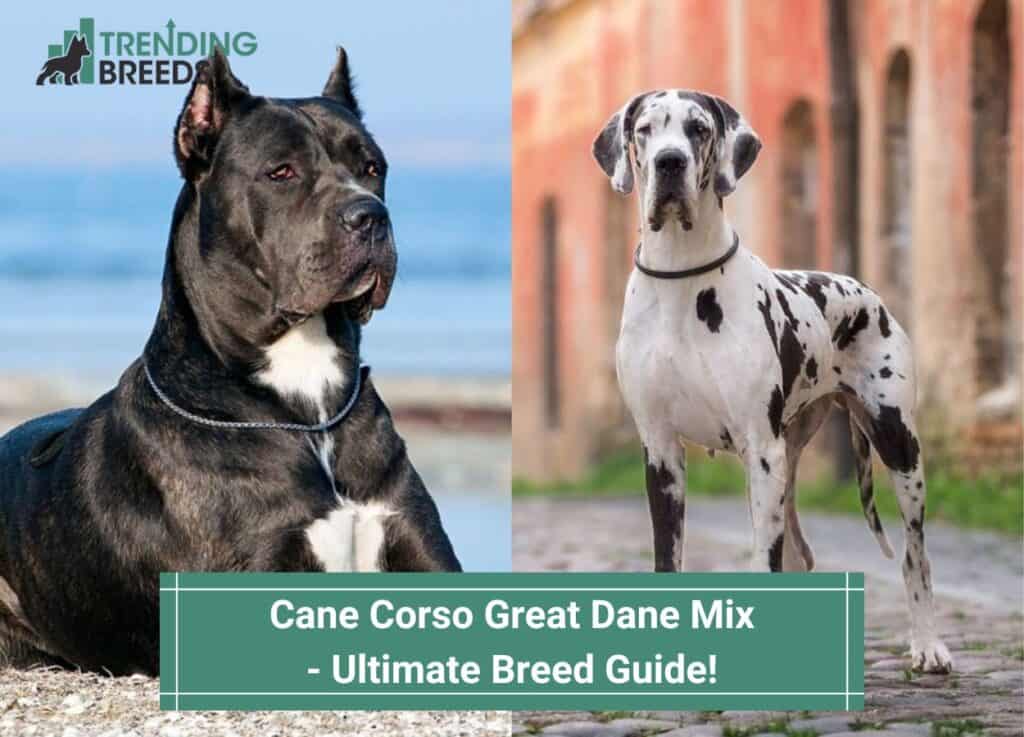
Undoubtedly, you’re seen or heard of both the Cane Corso and Great Dane. The Cane Corso can trace its lineage to being a war dog in ancient Rome. The Great Dane is known to have been around for at least 400 years, possibly going as far back as the Medieval Ages.
The question, of course, is what puppies would be like after crossbreeding. Let’s start by discussing each breed and then putting them together.
Other articles you would like: Do Great Dane Puppies Change Color? and Do Cane Corsos Drool A Lot?
Table of Contents
Cane Corso
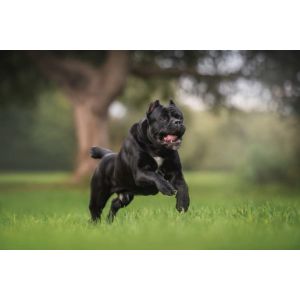
The Cane Corso is very intelligent and loyal to his family, but it can be challenging to train for several reasons, including strength and temperament.
Physical Characteristics
The Cane Corso looks intimidating. This Italian mastiff is a well-muscled dog with a large blocky head that holds itself with easy confidence. The American Kennel Club (AKC) states that a Cane Corso can reach 28 inches at the shoulder and weigh more than 100lbs.
Their short, coarse coats come in several solid colors: black, fawn, gray, gray-brindle, red, black-brindle, and chestnut-brindle. While show regulations encourage a solid coat, they may have a black or gray mask.
Temperament
Cane Corsos are often guard dogs using both their physique and attitude. They’re confident dogs, giving off an intimidating air to discourage intruders, but they’re also intelligent. The Cane Corso is a quick-witted breed that is eager to please and learn from its surroundings. It’s that same intelligence that can make them challenging to train for unwitting owners.
Dogs from this breed need to be properly socialized early on with positive training. Regardless of this potential hurdle, the Cane Corso is intensely loyal to their family. It’s a characteristic that makes any trouble raising them worthwhile.
Great Dane

The Great Dane is a gentle giant preferring to laze around the house rather than guard it. We’ll describe below all the important characteristics.
Physical Characteristics
The Great Dane is known for their size, standing at heights of up to 32 inches at the shoulder and reaching weights of 175lbs. Despite their massive size, this breed is elegant and has an easy gait.
Their coat comes in various colors:
- Black
- Black and white
- Blue
- Blue and white
- Blue brindle
- Brindle
- Chocolate
- Fawn
- Harlequin
- Merle
- Silver
- White
- Chocolate and white
- Chocolate brindle
- Mantle
- Mantle merle
- Merlequin.
Their smooth coat can come with different markings as well:
- White
- Merle
- Black
- Fawn
- Black mask
- Blue mask
- Piebald
- Brindle
- Blue
- Chocolate
- Chocolate mask
Temperament
The Great Dane is an easygoing breed, intensely loyal to family, and with immense patience. It’s no coincidence the breed was used as a model for the famous cartoon dog, Scooby Doo. They respond well to positive and consistent training from every family member.
Like the Cane Corso, early socialization with people and animals is a crucial step in raising one of these gentle giants.
Cane Corso and Great Dane Mix
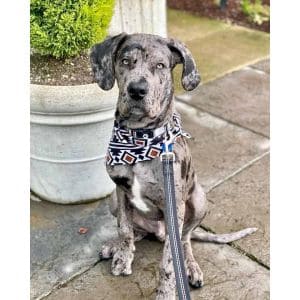
You might think a Cane Corso Great Dane mix is just too much. Both breeds are large, intelligent, and with the potential to be very strong-willed. But this hybrid, also known as the Italian Daniff or Corso Dane, or Great Corso, has the potential to be a unique, remarkable breed. The mix can bring the best of both dogs to the table if bred correctly.
Cane Corso vs Great Dane
There are some differences between the two breeds. Regarding height and weight, the Great Dane is the bigger of the two. The Cane Corso is “just” large, while the Great Dane is a giant. This immense size, however, has a downside, and that’s the Great Dane’s shorter life span.
Italian Daniff Physique
The Great Dane Cane Corso mix is considered a designer breed. They can stand between 27 to 33 inches, making them even taller than some Great Danes, and they can weigh anywhere between 115 and 190lbs.
Their chest is broad, a characteristic they have inherited from the Cane Corso’s physique. They also have a more square and pronounced head, defined snout, and their ears are floppy.
Why Is the Italian Daniff Larger?
The breeders of mixed dogs want you to believe that they’re providing you with healthier dogs, that there’s less inherent inbreeding. It’s thought that this could be one reason why the Cane Corso mixed with Great Dane is larger than its breeds of origins.
However, Dr. Jerry Klein, CVO, doesn’t believe this to be the case. Instead, he outlines that there’s research stating dogs, whether mixed or not, are all vulnerable to specific health ailments. And that this makes sense because “…most domesticated dogs are believed to be the descendants of just a handful of lines of wolves. As a result, all dogs share strong genetic tendencies, some of them health-related.”
Colors and Markings
When it comes to colors and markings, the Cane Corso mix with Great Dane has a wide variety. The typical colors are
- Black
- Isabella
- Blue
- Fawn
- Brown
It’s also possible for them to have many of the same markings as the Great Dane.
Coat Type
The Great Dane and Cane Corso mix has a short, straight, and dense coat.
Grooming
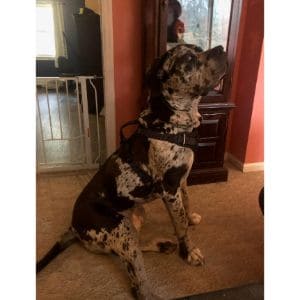
Thankfully, while the Italian Daniff is a huge dog, it’s not a dog that requires the constant brushing that other breeds require. A weekly brushing will suffice in keeping the hair down in this single-coated breed and off the floors of your home.
Activity Requirements
The Great Dane and Cane Corso mix requires about thirty minutes of daily activity. Because of their large size, this breed isn’t a fan of excessive exercise or running around for a long time. Their size and potential for knee problems also don’t make them a good candidate for jumping activities.
Instead, consider taking your dog for leisurely walks around the block. This will give your pet plenty of time to bond with you and get his blood pumping. It can also be a great socialization tool.
Personality
This hybrid breed dog is known for having a docile, patient temperament taking after its Great Dane heritage. It’s a beautiful family dog, loyal to its people, and enjoys spending quality time with you.
It’s not a very active dog, and while it will take up a lot of space in your house, it’s content to rest with you while you enjoy the end of your day. This dog is docile and not known for barking loudly at intruders or causing a fuss.
Potential Health Issues
A giant breed, the Cane Corso Mix with Great Dane breed comes with a few possible health ailments.
Elbow Dysplasia
Canine Elbow Dysplasia is a condition that results in the elbow joint of large breed dogs not growing correctly. Only three small bones make up the elbow joint, so if something happens when the puppy matures, such as growing too fast, each step will place too much weight on the joint.
Naturally, this condition in a dog the size of a Cane Corso and Great Dane mix can be devastating. It’s progressive and can lead to arthritis in both elbows, joint pain, and eventual loss of mobility.
Dogs suffering from elbow dysplasia can show symptoms as early as five months, while others may wait years for a diagnosis. It can start with limping, favoring one leg, or it may not show until it progresses.
Surgery is sometimes a solution, but it’s not a fix for every dog. In those situations, medication may offer some pain relief.
Canine Hip Dysplasia
Any dog can get Canine Hip Dysplasia, but it’s most common in large and giant breeds, including Great Danes, and is often hereditary. Naturally, it can occur in the Cane Corso and Great Dane mix.
Dysplasia occurs when the two parts of the hip (the ball and socket joint) don’t sit together properly. As the dog moves, the bones grind and rub against one another. Growth spurts, and too much exercise as puppies, among other factors, can also trigger this.
Just like in humans, growth spurts in puppies can cause joint problems. They are also one of the leading causes of hip dysplasia. The great news is that some changes in diets early in life can prevent or reduce the risk of it. Speak to a veterinarian to see if they recommend a diet change.
Signs of canine hip dysplasia are a hard time running or jumping, limping, or if they seem to be in pain.
Depending on how progressed the dysplasia is, you may be able to treat them in several ways. Weight reduction, activity restriction, and water physical therapy are all ways that you can reduce the stress on your giant breed’s joints.
Your veterinarian may also recommend joint supplements or anti-inflammatory medications.
One silver lining is that many of these preventative therapies and remedies for hip dysplasia can also help with elbow dysplasia if you’re unlucky to be diagnosed with both.
Bloating
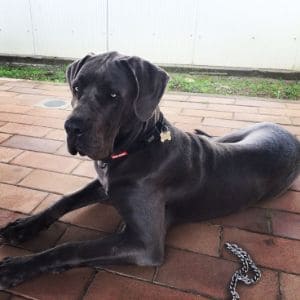
Bloating is estimated to affect tens of thousands of dogs a year, but the good news is that it’s entirely avoidable and doesn’t have to happen to your dog.
The condition is serious and can be fatal if left untreated. It occurs when a dog’s stomach fills with gas, food, and water and flips, twisting it. If you suspect bloat, call and then proceed immediately to the nearest animal clinic because it’s always an emergency.
If a dog’s stomach has bloated but not flipped, it may resolve independently. However, this isn’t something you should decide on your own. Bring your dog to the vet and allow trained professionals to observe them.
A bloated stomach on its own can restrict blood flow, but twisted bloat will restrict blood flow to major organs. The dog’s system can become overwhelmed with toxins as the organs cannot function correctly, then go into shock.
Large and giant breed dogs seem more susceptible than smaller breeds, but all breeds can experience bloat. The condition is even more common in large breed dogs with deep chests, such as the Great Dane. The AKC says that the Great Dane is 5 to 8 times more likely to experience bloat than dogs with a different chest-to-height ratio.
Some risk factors include
- Eating too quickly
- Overeating
- Drinking large quantities of water in a short period
- Raised food bowls
- Stress
- Exercising after eating
- Genetics
- Increased age
Signs of Bloat
Common signs of bloat are pacing, unusual behavior and a swollen or distended abdomen. If you touch your dog’s stomach and they seem to be in pain, this can be a symptom. Other signs include:
- Distress
- Unsuccessful attempts to vomit, dry-heaving
- Drooling
- Panting and rapid breathing
- Collapse
Treatment
A dog diagnosed with bloat needs surgery to have its stomach flipped back into place. Damaged tissue will need to be removed, and the stomach will likely be sutured to the wall of the abdomen to prevent it from flipping again in the future.
Veterinarians sometimes recommend gastropexy as a preventative measure in large and giant breed dogs. Of course, you should always speak with your veterinarian before rushing into attempting to schedule one.
- Up to 80% of dogs that receive prompt medical treatment will survive bloat.
Prevention
A few simple prevention methods can save you a lot of pain and suffering:
- Feed your dog smaller meals throughout the day.
- Do not raise your dog’s food bowls.
- Don’t allow your dog to drink large amounts of water all at once
- Avoid exercise right after eating or drinking
Great Dane and Cane Corso Mix Origins
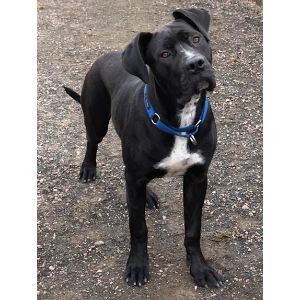
Unfortunately, the origins of the Italian Daniff aren’t well known. It’s estimated that the breed appeared about fifteen years ago, but there’s no documented information on who decided to cross the two dogs initially.
Looking To Buy A Cane Corso and Great Dane Mix?
The Cane Corso mix with Great Dane is a delightful designer breed that’s sure to fit the needs of many families. It possesses a gentle personality and patient nature and is well suited to consistent training like its parent breeds.
However, like with any purchase of a dog, designer, or purebred, do your homework on potential breeders. Ask for references and try to contact past buyers. Many breeders will claim that because their puppies are a mixed breed, they’re far healthier than purebreds. Which may not be entirely true.
Ask for medical history, including genetic test result. Also, if you can, meet the parents as they can pass down behavior problems. A reliable breeder will be proud of their Italian Daniffs and happy to offer you this information.
Conclusion For “Cane Corso Great Dane Mix!”
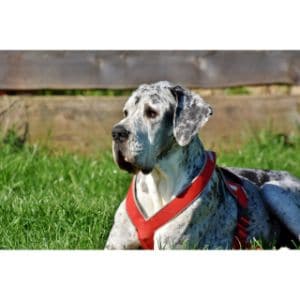
The Cane Corso mix with Great Dane is a delightful hybrid breed that’s sure to fit the needs of many families. It possesses a gentle personality and patient nature. It’s also well suited to consistent training like its parent breeds.
However, like with any purchase of a dog, designer, or purebred, you should do your due diligence regarding breeders. Many will claim that because their puppies are a mixed breed, they’re far healthier than purebreds.
But this may not be entirely true. Ask for information on the parents, including medical history and whether they’ve been at risk for any of the previously mentioned conditions. A reliable breeder will be happy to offer you this information.
You will also like:
For more Great Dane Mixes, check out the video below:

